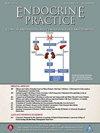Diagnostic Performance of Noninvasive Tests for Identifying Advanced Fibrosis in Metabolic Dysfunction-Associated Fatty Liver Disease With Mixed Etiologies
IF 4.6
3区 医学
Q2 ENDOCRINOLOGY & METABOLISM
引用次数: 0
Abstract
Objectives
To assess the performance of fibrosis-4 index (FIB-4), nonalcoholic fatty liver disease fibrosis score (NFS) and aspartate aminotransferase to platelet ratio index (APRI) for advanced fibrosis in metabolic dysfunction-associated fatty liver disease (MAFLD) subgroups categorized by concomitant liver conditions.
Methods
We conducted a multicentered study comprising inpatients with type 2 diabetes mellitus and MAFLD. Participants were categorized into 2 groups: MAFLD with pure metabolic etiologies (MAFLD-P) and MAFLD with mixed etiologies (MAFLD-M). Diagnostic performance of FIB-4, NFS, and APRI was assessed by area under the curve (AUC), sensitivity, and specificity.
Results
This study comprised a total of 1475 participants, with a mean (SD) age of 58.4 (13) years and 835 (56.6%) males. FIB-4 and APRI had higher AUCs for advanced fibrosis in the MAFLD-M group than in the MAFLD-P group (MAFLD-M vs MAFLD-P: FIB-4 0.680 vs 0.591, P = .0442; APRI 0.723 vs 0.631, P = .0363). No significant difference was observed in the AUC of NFS between the 2 subgroups (MAFLD-M 0.572 vs MAFLD-P 0.617; P = .3237). Besides, the sensitivity of FIB-4 (69.6% vs 54.0%; P = .019) and APRI (43.5% vs 26.1%; P = .005) was higher in the MAFLD-M group. However, no significant difference in sensitivity of NFS and specificity of FIB-4, NFS, and APRI was observed between subgroups.
Conclusions
In this diagnostic study of the type 2 diabetes mellitus population, FIB-4 and APRI showed better performance for identifying advanced fibrosis in MAFLD with mixed etiologies.

非侵入性检查对混合病因的代谢功能障碍相关脂肪肝晚期纤维化的诊断性能
目的:评估纤维化-4指数(FIB-4)、非酒精性脂肪性肝病纤维化评分(NFS)和天冬氨酸转氨酶血小板比率指数(APRI)在代谢功能障碍相关脂肪性肝病(MAFLD)亚组中晚期纤维化的表现。方法:我们进行了一项包括2型糖尿病(T2DM)和MAFLD住院患者的多中心研究。参与者被分为两组:纯代谢病因(MAFLD- p)和混合病因(MAFLD- m)。通过受试者工作特征曲线下面积(AUC)、敏感性和特异性评估FIB-4、NFS和APRI的诊断效能。结果:本研究共纳入1475名参与者,平均(SD)年龄为58.4(13)岁,男性835(56.6%)。MAFLD-M组FIB-4和APRI对晚期纤维化的auc高于MAFLD-P组(MAFLD-M vs MAFLD-P: FIB-4 0.680 vs 0.591, p = 0.0442;APRI 0.723 vs 0.631, p = 0.0363)。两亚组间NFS的AUC无显著差异(MAFLD-M 0.572 vs MAFLD-P 0.617;P = 0.3237)。此外,FIB-4的敏感性(69.6% vs 54.0%;p = 0.019)和APRI (43.5% vs 26.1%;p = 0.005), MAFLD-M组较高。然而,不同亚组间NFS的敏感性和FIB-4、NFS和APRI的特异性均无显著差异。结论:在这项T2DM人群的诊断研究中,FIB-4和APRI在识别混合病因的MAFLD的晚期纤维化方面表现更好。
本文章由计算机程序翻译,如有差异,请以英文原文为准。
求助全文
约1分钟内获得全文
求助全文
来源期刊

Endocrine Practice
ENDOCRINOLOGY & METABOLISM-
CiteScore
7.60
自引率
2.40%
发文量
546
审稿时长
41 days
期刊介绍:
Endocrine Practice (ISSN: 1530-891X), a peer-reviewed journal published twelve times a year, is the official journal of the American Association of Clinical Endocrinologists (AACE). The primary mission of Endocrine Practice is to enhance the health care of patients with endocrine diseases through continuing education of practicing endocrinologists.
 求助内容:
求助内容: 应助结果提醒方式:
应助结果提醒方式:


